The Levi’s AMC Gremlin wasn’t just quirky—it fashioned a movement
The AMC Gremlin has undergone some serious image rehabilitation in the last 20 years. Launched on April Fools’ Day, 1970, the Gremlin immediately became a successful part of American Motors’ lineup, outselling the Javelin, Ambassador, and even the Matador. Unfortunately, AMC failed to update the car frequently enough. By the mid ’70s it had become woefully outdated compared to the small-car competition like the Vega, Pinto, and Corolla.
AMC built a total of 671,475 Gremlins from 1970 to 1978, and some of the obvious features collectors look for are V-8 engines, manual transmissions, and the sporty “X” package. But perhaps the most desirable option out there is the Levi’s jeans interior.
Before we get to that denim delight, however, you may be asking “Wait a minute—people collect these things?” The lack of updates, combined with the inconsistent quality of all domestic economy cars of that era, caused the unique-looking Gremlin to become an object of ridicule in pop culture throughout the ’80s and ’90s. Movies, TV commercials, and “Top Ten Worst Car” chain emails constantly ragged on the little Gremlin. The messaging was clear: This was a dorky car driven only by losers.

Despite this, Gremlin values have actually risen in the collector market as of late, so much so that it’s hard to find a decent one today for under eight grand. True aficionados appreciate this is a unique car for its eye-catching—albeit, polarizing—style. And with the right powertrain they can be a lot of fun to drive, too. (Especially the Gremlin 401 XR.) Far from being the butt of jokes, Gremlins have become bonafide collectibles. Their quirkiness has become endearing, even cool.
I’ve learned a lot about American Motors in the last few years, as I’ve been interviewing former employees for a documentary series about the company. You can check out our trailer and learn more about our project, here:
Our crew has talked to a huge range of former AMC employees, from assembly line workers to two CEOs. While everybody has a story to tell, some one of my favorite anecdotes was learning about the very special Levi’s Gremlin.
Starting for ’73 and running until the model’s end, customers could order “seats of the pants” for their AMC Gremlin or Hornet, covered in a material that mimicked the look of Levi’s denim. The package came complete with metal buttons, copper-colored stitching, and a genuine Levi’s tag. It also included color coordinated door panels with real denim pockets, special blue trim, and a Levi’s logo on the fenders.

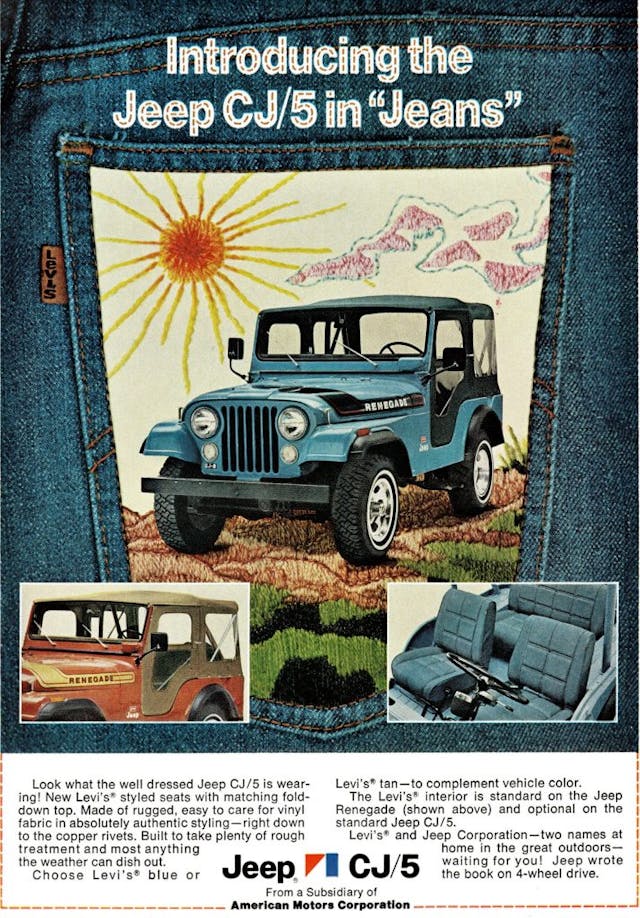
Eventually the Levi’s interior made its way into AMC’s Jeep division, where it showed up in Cherokees, J-series trucks, and the iconic CJ line. It also made a one-year appearance in the ’77 Pacer and ’78 (Concord) AMX. Jeeps used a slightly heavier material than passenger cars and offered both blue and tan versions; cars were blue only, except for ’78. In the final year, customers could get their pants seats in blue, black, tan, or berry.
All in all, the Levi’s interior was the kind of fun option that makes people nostalgic for a time when car companies were more creative and less risk-averse. It also was a sign of just how culturally powerful blue jeans had become by the 1970s. The Levi’s Gremlin was more than just AMC’s strategy to win over Pinto and Vega shoppers; it was a symbol of a changing America.
As explained in Riveted: the History of Jeans, prior to the 1950s, blue jeans were used primarily as work clothes. Either as bib overalls or trousers (also called “waist overalls”), denim was worn by farmers, ranchers, miners, factory workers, mechanics, or anybody else who did dirty, physical labor for a living. Occasionally wealthy urbanites wore jeans when pretending to be cowboys, but the clothes certainly weren’t common.
After WWII, returning veterans continued to wear jeans when they left the service, spreading the clothing’s popularity. Thanks to movie stars like James Dean and Marlon Brando, denim jeans became the new look for cool, rebellious youth. Naturally, uncool, un-youthful people hated this, and they did everything they could to stop teenagers from wearing jeans. Naturally, this only made jeans cooler.
To combat the image of making clothes only for young miscreants and old farmers, denim companies launched a promotional campaign to clean up the image of jeans. They were marketed as respectable clothes for active people. But it turned out cheery propaganda films were nothing compared to the marketing power of hippies and rock n’ roll.

The rapid growth of the middle class during the 1950s had created a new generation of teenagers with massive buying power: baby boomers. By the late ’60s, jeans had taken off as the clothing of choice for millions of boomers, and companies everywhere were eager to cash in. Rock stars wore jeans. Hippies wore jeans. Regular kids who wanted to look like rock stars and hippies could also wear jeans. The image of youth rebellion was distilled, commodified, packaged, and sold back to them in the form of jeans. That’s where American Motors entered the picture.

As the company regained its footing after a tumultuous end to the 1960s, new leadership looked to set AMC apart from its Big Three competition. One strategy included offering special designer interiors for their cars, touting well-known names in fashion. The AMC Hornet Sportabout wagon came first, with a Gucci edition for ’72 and ’73. Next followed the ’72-’73 Javelin, which offered a Pierre Cardin interior.
Both featured the names and influence of European fashion designers, giving AMC a dose of high culture to boast about. Next, VP of Marketing William McNealy wanted to do something decidedly more mainstream: a Levi’s jeans interior. After the agreement was hammered out, McNealy put AMC’s head of interior design, Vince Geraci, in charge of the project. During an interview with me, Geraci explained how they created the car that wore the pants:
“So, my wife Susie and I went to San Francisco to see the Levi people … and they say, ‘We would like to have the design work and the sewing style and the pleating and everything that goes in there. See if you can coordinate the same feel of the trousers and what we do. We’ll give you samplings and cuttings of all of the different Levi materials that we use.’”

The challenge for Geraci and his team was that they couldn’t use actual denim in the car. The material didn’t meet safety regulations for flame retardation and it couldn’t withstand the wear and abuse that a car seat goes through over the years.
“But we wanted to capture the feel of the material, the coloration of the material, and the details associated with Levi itself,” he explained. “The buttons, the orange stitching, and the little tag that says ‘Levi.’ And in doing that we brought back many cuttings of Levi material … and Louis Zolliker, who was fabric manager of the interior studio, she took a bunch home, and my wife took a bunch home. And we washed them to get that look that we liked. [We wanted] a little bit of wear but nothing significant, so it gives it that nice soft feel.”
After running the samples through the washing machine again and again, Geraci and Zolliker took their samples to work, and the stylists decided which ones they liked best.
“So in doing that, we finally came up with the look that we liked,” Geraci explained, “So we brought in Milliken & Company, who is one of the largest manufacturers of carpet and interior trim material for the Big Three.”

Zolliker became the point person and worked with Milliken designers to create a look-alike fabric that also met safety and durability standards for automotive use. The Levi’s interior was launched for 1973 as an option on the Gremlin and the new Hornet Hatchback. Both cars already appealed to teenage baby boomers with their unusual shapes, bright exterior colors, and low prices, and now they had a feature that no one else offered.
AMC created more designer interiors, including an Oleg Cassini Matador, as well as some “store-brand” fancy interiors like the Barcelona package for the Matador. Of all their special trims, Levi’s seems to be the most famous.
“After the program had gone and had been in other vehicles, [Millikan] said… that was the largest run of one color fabric they had ever made,” Geraci told me with a smile, proud to have contributed to the material’s success.

Despite its popularity, AMC Levi’s cars can be hard to find today. According to our valuation tools, a Levi’s interior can add 20 percent to the value of a Gremlin. Combined with the optional 304 V-8 and X package, it can make for a pretty special little car. Unfortunately, the fabric can wear out and get a little ratty, but there are reproduction options you can buy.
AMC’s venture into the world of designer interiors only lasted about a decade, but it created some very memorable models. The Levi’s package was an interesting confluence of marketing, pop culture, and design, all coming together at the right time. Reflecting on its success, Vince Geraci told me it was the kind of thing only AMC could pull off.
“When I ultimately went to Chrysler and I spoke to the people in interiors at Chrysler, they said, ‘You know, we really wanted to do a Levi’s interior also, but sales didn’t know if they could sell as many, and the dealers didn’t know if it was gonna be popular enough, and we didn’t know about the pricing, and we didn’t know about this and that …’ That’s the difference between American Motors and the rest of the industry… Here’s the contract, these are the people, get it done, and get it in a car. Period!”

Nearly fifty years after he worked on the design, Geraci recently became the proud owner of a Levi’s Gremlin. It’s a 1973 Gremlin X with the coveted factory 304 V-8 and a Levi’s interior. The car previously belonged to the late Gremlin collector Brain Moyer and had been lovingly restored by him. Although I haven’t seen it in person yet, I will be visiting Vince later this summer, and I know he’s thrilled to show his “car that wears the pants.”
Vince Geraci is just one of the many colorful employees who appear in our documentary series, The Last Independent Automaker. I can’t wait to share more AMC stories like his when our series debuts in 2024.

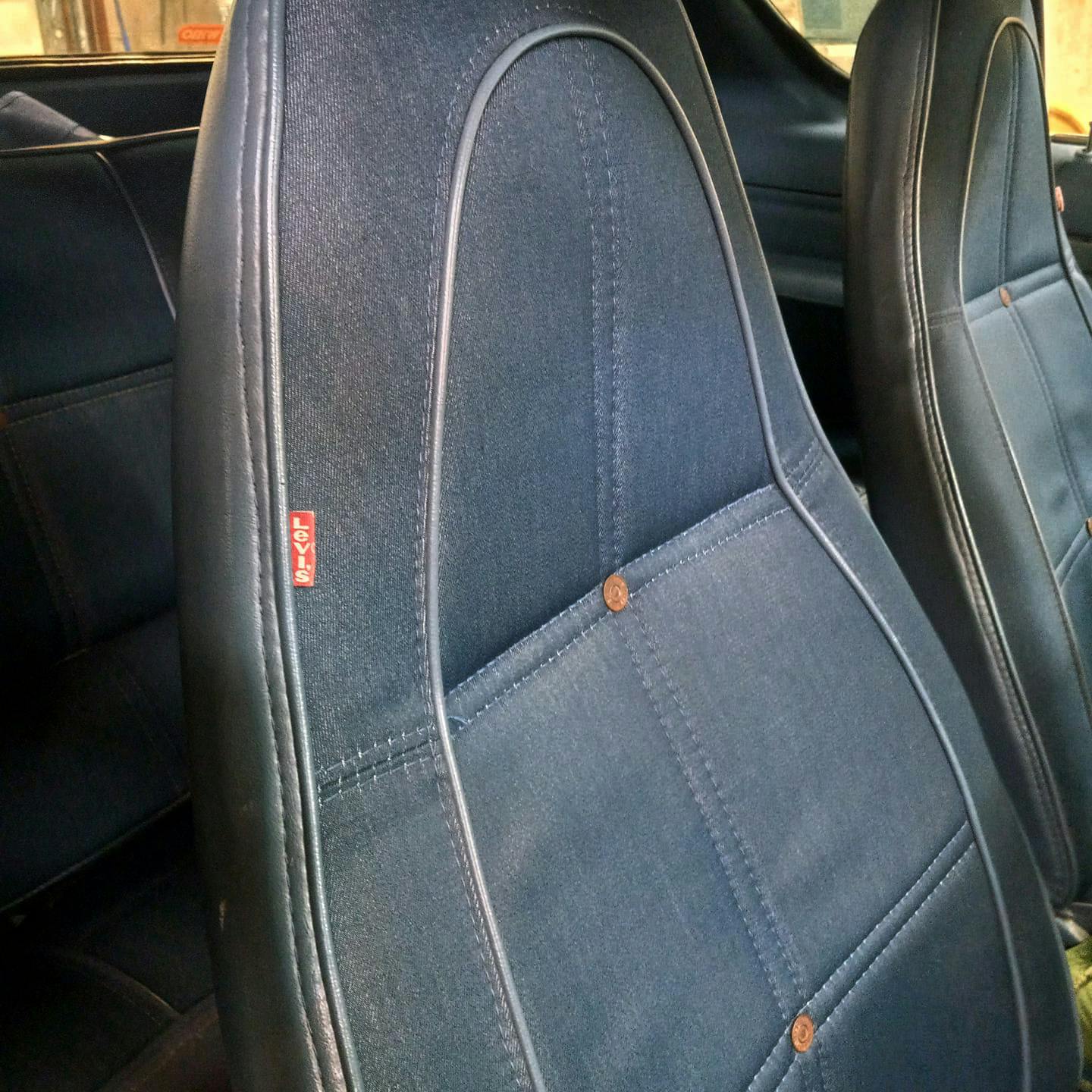

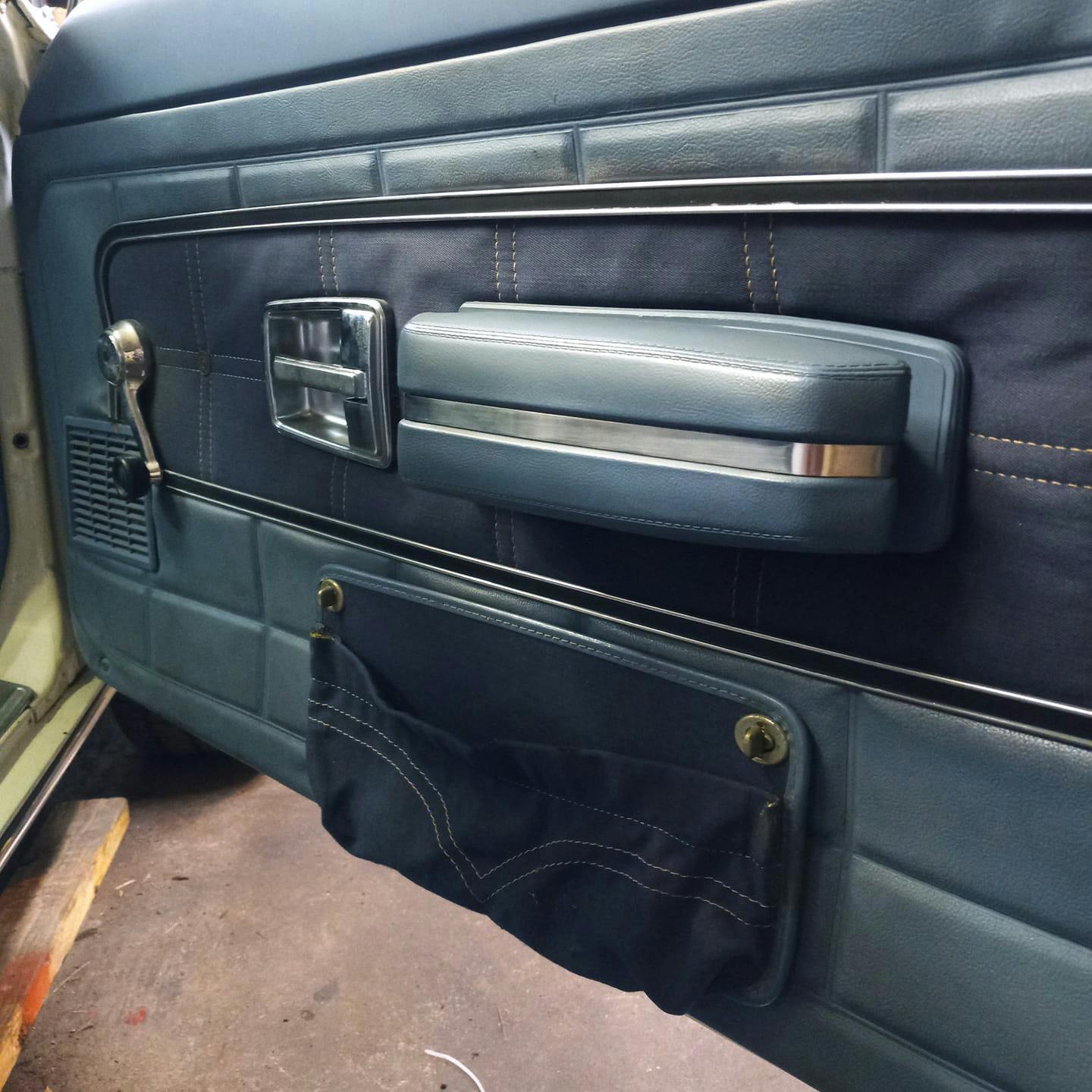
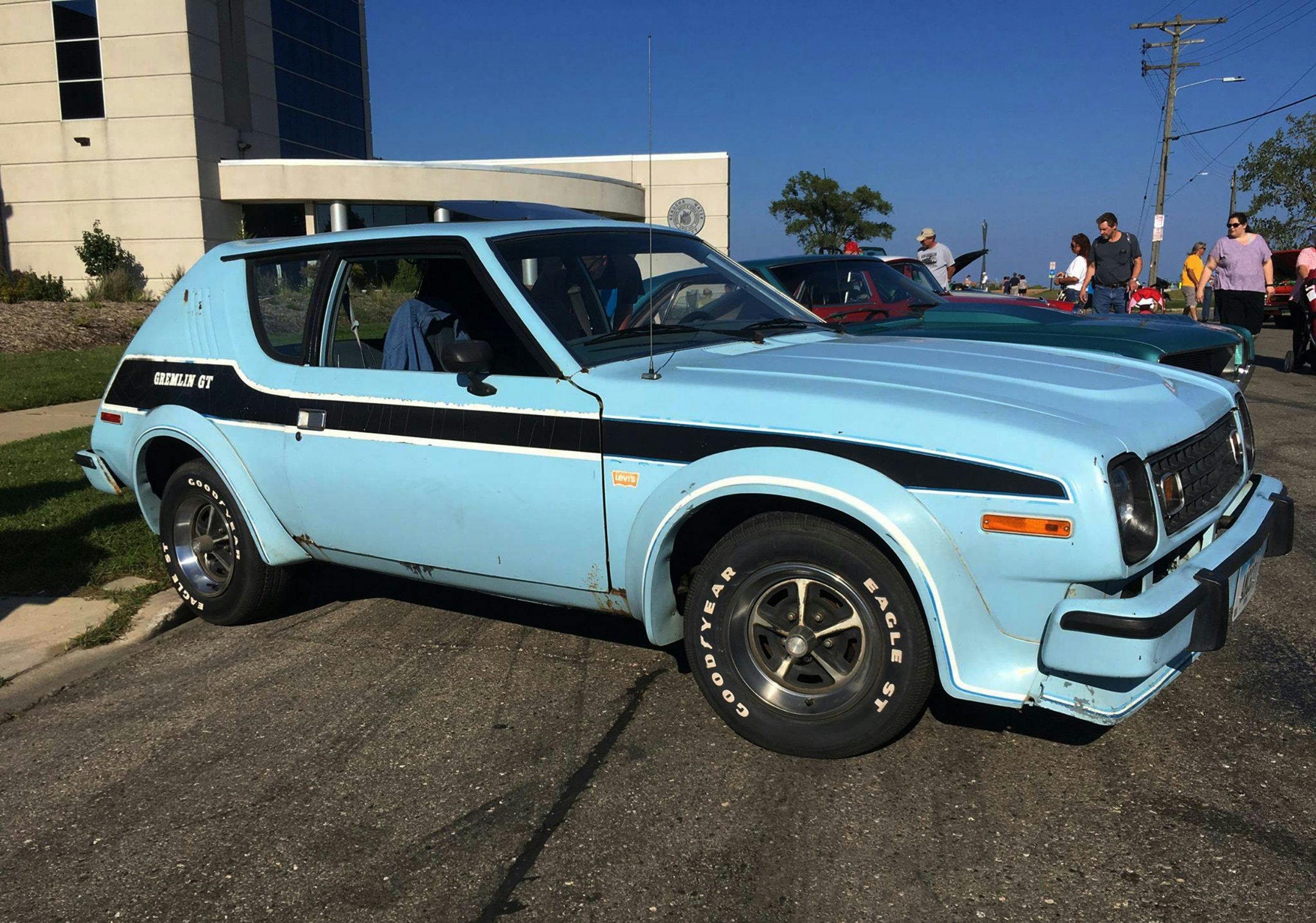
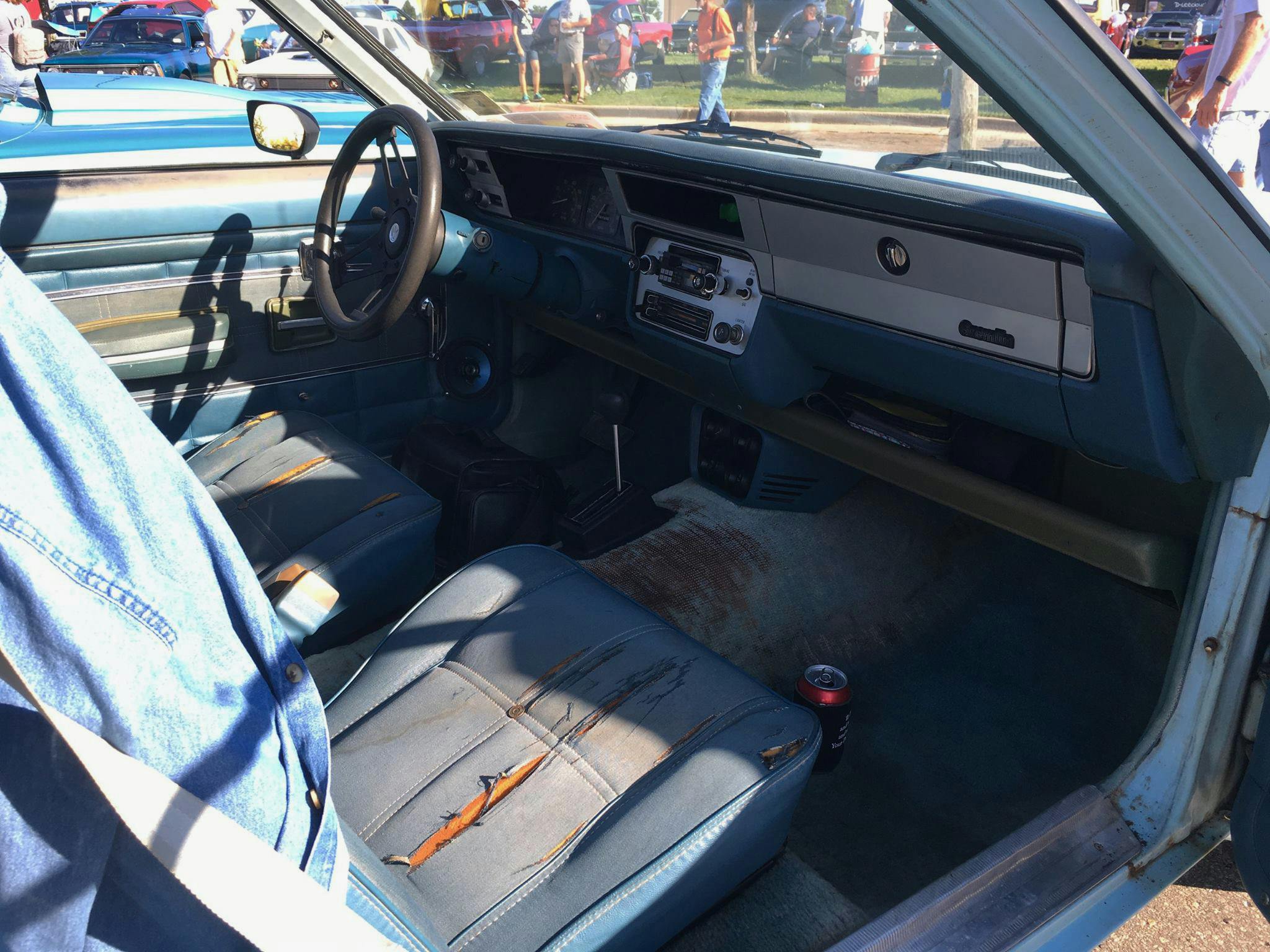
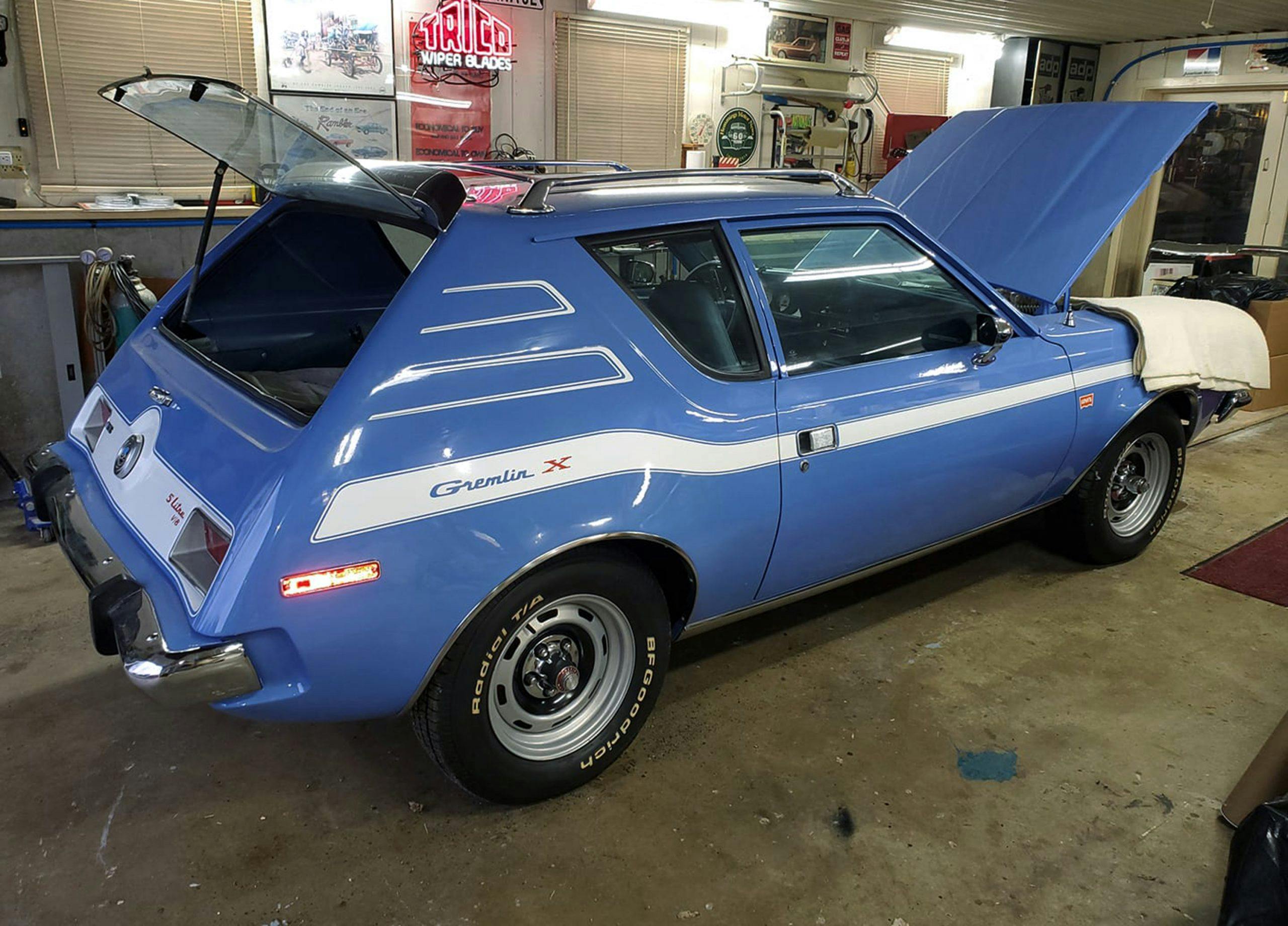

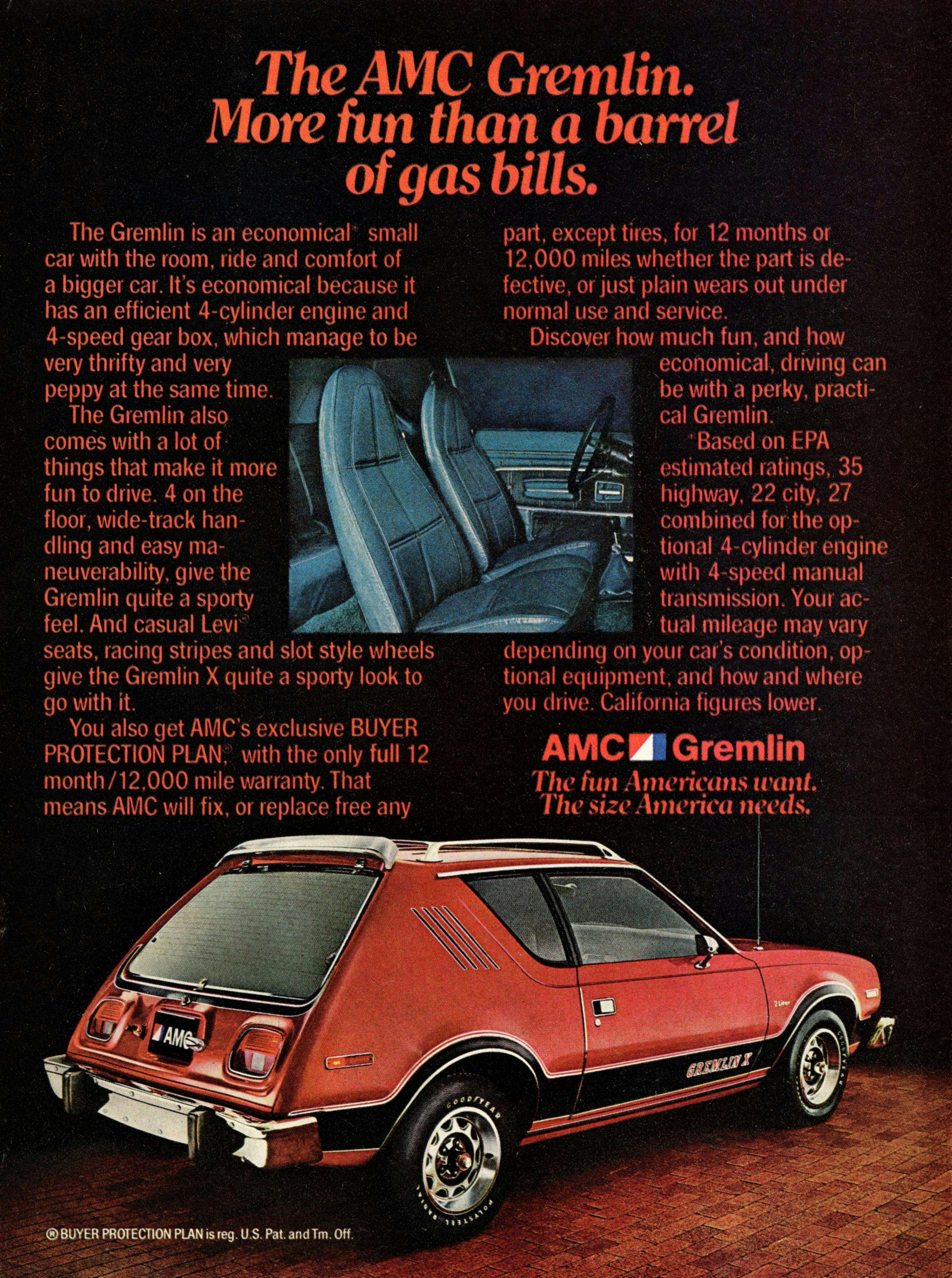
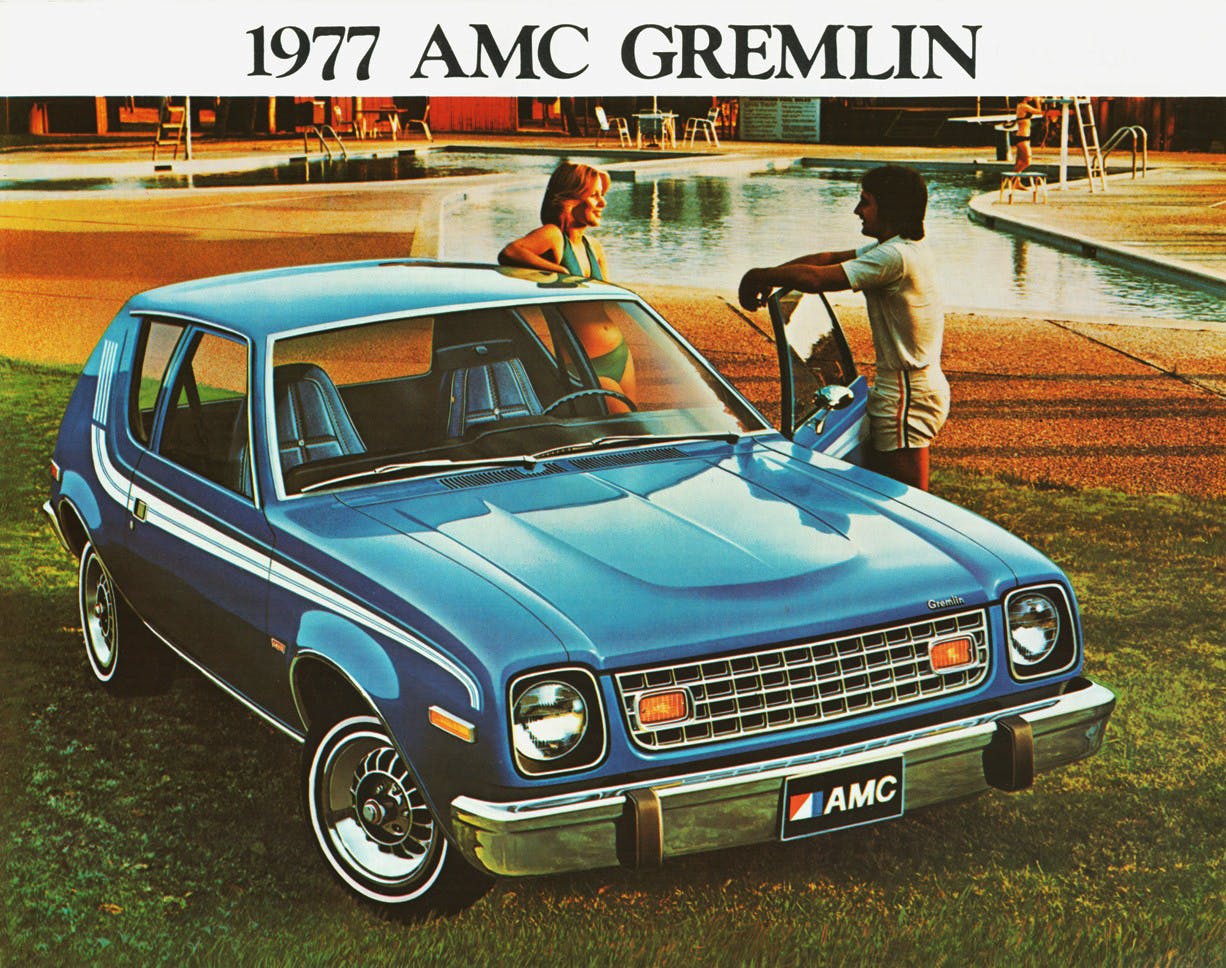

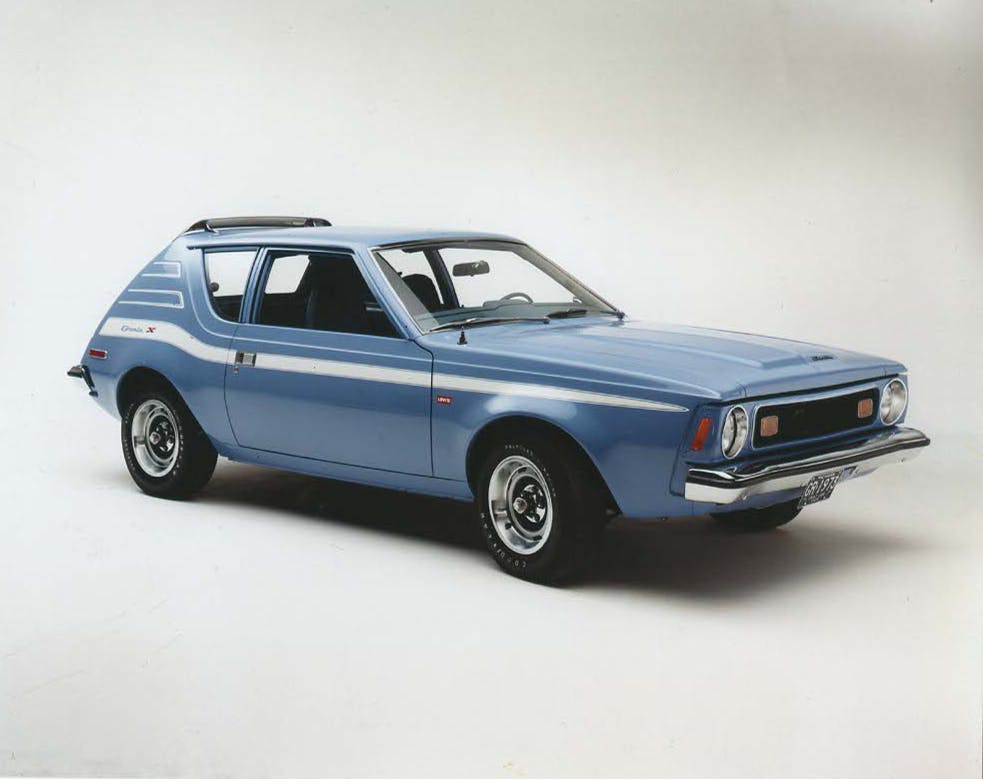

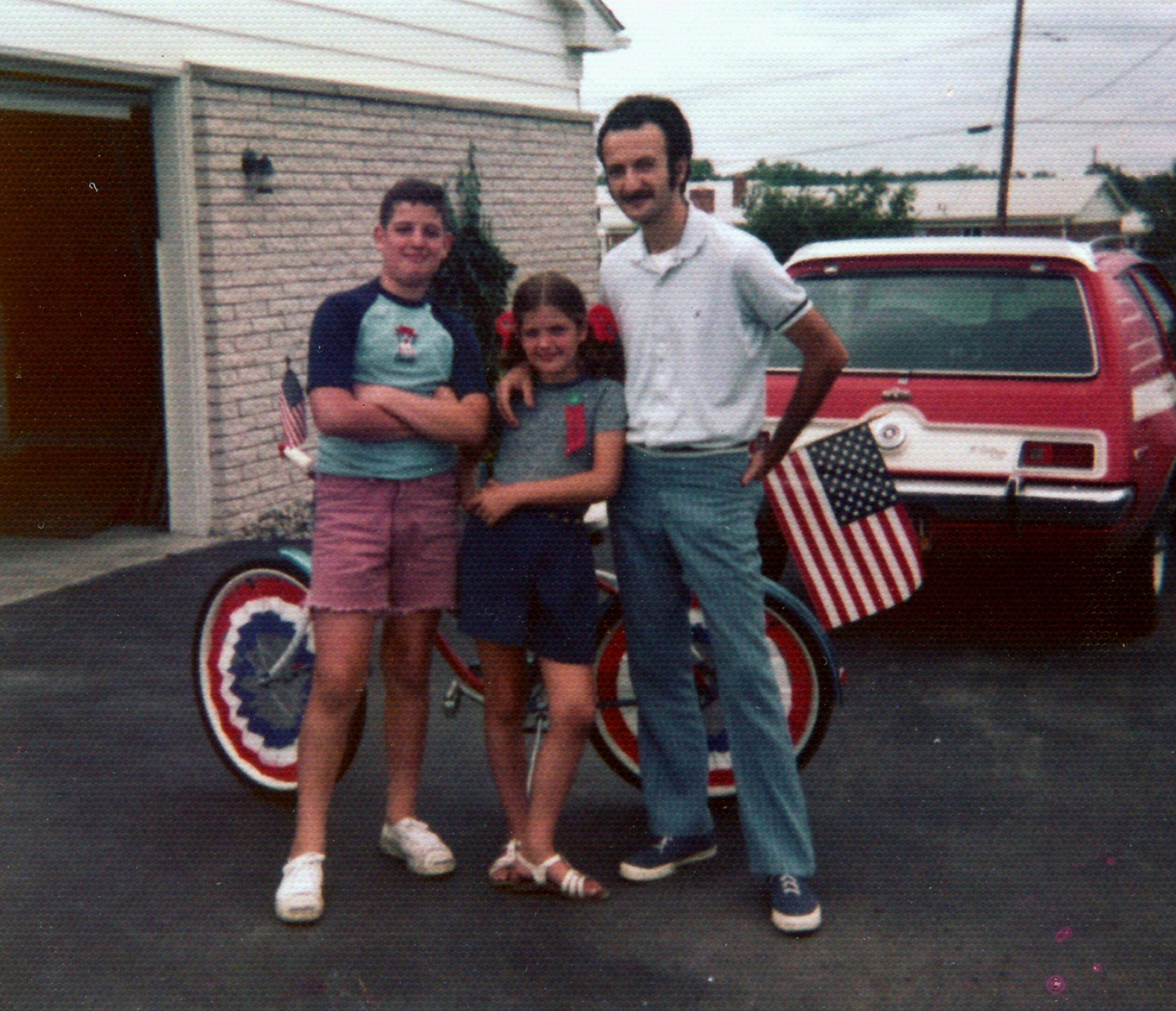


I AM A JOURNALIST FOR THREE MAGAZINES 2 CAR ONES AND I WANT TO DO AN ARTICLE ABOUT LEVI GREMLINS CAN SOM EONEM TEXT OR CALL ME PLEASE SCOOTER 616-334-3641 GRAND RAPIDS MICH
I met an actor in 1970s Brooklyn. His only role that I’m aware of was saying “Hey, this car is wearing pants” in a Gremlin ad.
WHY ARE YOU YELLING?!
The Gremlin was truly ahead of its time. AMC was the only American car company to take risks on design ideas, and they were rewarded with huge sales & a cult following.
I met an actor in 1970s Brooklyn. His only role that I’m aware of was saying “Hey, this car is wearing pants” in a Gremlin ad.